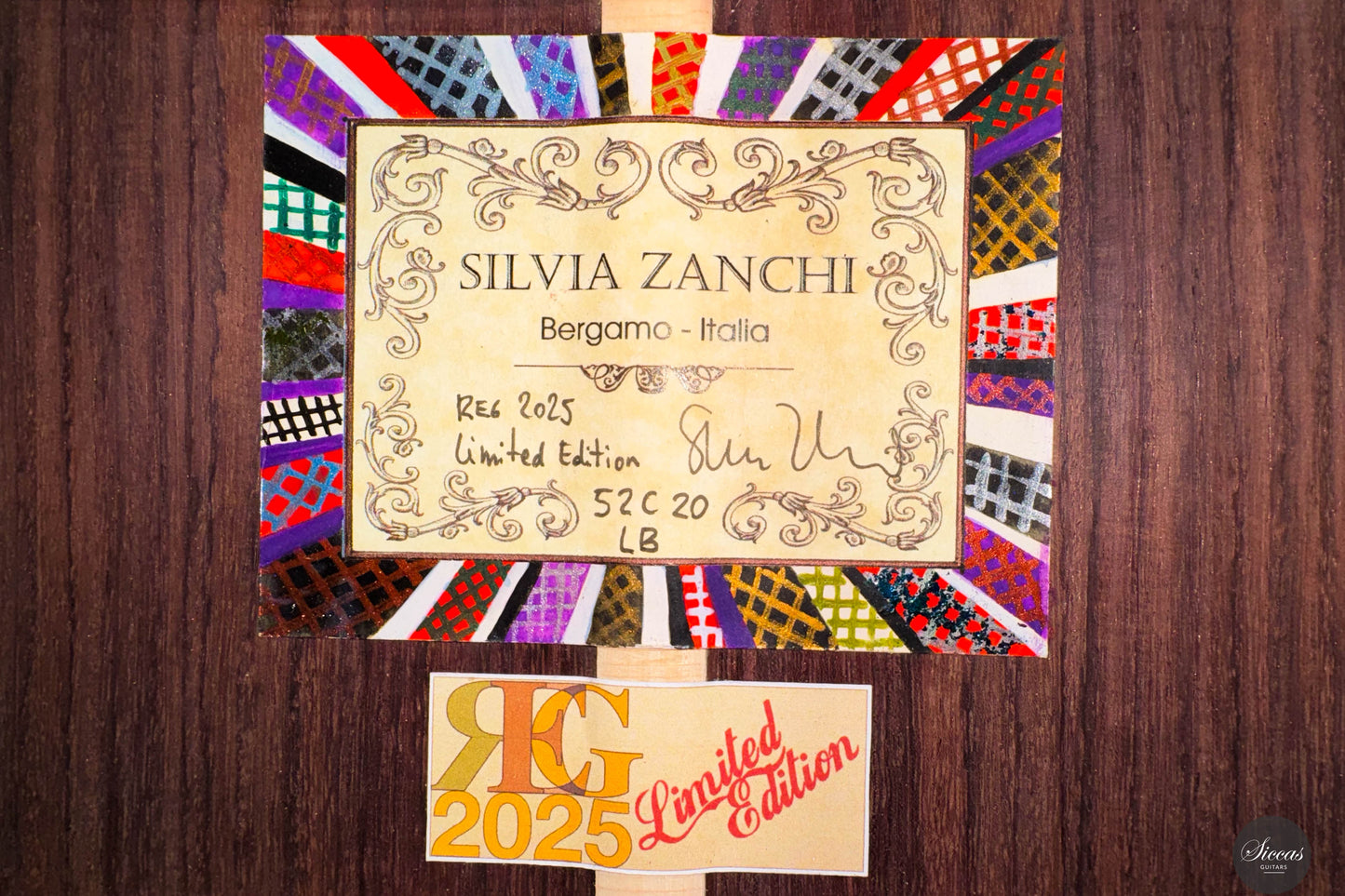Silvia Zanchi - 2025 - REG Limited Edition Lattice
Silvia Zanchi - 2025 - REG Limited Edition Lattice
Details
Details
Overview
Overview
Shipping important note
Shipping important note
Delivery times are typically reliable and most instruments arrive within the estimated timeframe.
Should any unexpected delay occur, our team will keep you informed and provide support at every step. For all shipping details and exceptions, please see our Shipping Policy.
Details about GPSR
Details about GPSR





















Video overview

More details about the guitar
About the luthier
Silvia Zanchi, based in Bergamo, specializes in the construction of classical concert guitars, plucked instruments for early music, and the restoration of historical plucked instruments. After studying at the Liceo Artistico Statale in Bergamo, she graduated from the Civica Scuola di Liuteria in Milan, where she focused on building and restoring early music plucked string instruments. Since 2006, she has collaborated with lutherie schools (Civica Scuola di Liuteria di Milano, Accademia di Liuteria Piemontese, Cr Forma Cremona, Scuola di Artigianato Artistico Centopievese), associations, institutions, companies, and music conservatories, teaching masterclasses on construction, varnishing, and restoration of plucked string instruments both in Italy and abroad. She primarily creates a personal model of traditional classical guitars, drawing inspiration from great masters of the past, while also exploring modern projects using new technologies and materials to meet contemporary guitarist needs. Her aesthetic choices, deeply influenced by her artistic background, highlight her attention to detail, which is a hallmark of her craftsmanship.About the guitar
The two REG Limited Edition 2025 guitars are the result of numerous experiments that led to the creation of a new model in Silvia Zanchi’s production. This model is designed for musicians who seek a more powerful sound and greater projection than a traditional guitar offers. This particular instrument is the Lattice Bracing model, conceived as the sister guitar to the Doubletop model, which is also available at Siccas Guitars. For this guitar, traditional materials were deliberately selected, aiming to achieve a very light soundboard, supported by a spruce lattice bracing system. This construction helps to counterbalance string tension, while allowing the soundboard to vibrate freely like a drum skin, resulting in outstanding projection and responsiveness. A distinctive aesthetic feature is the rosette, inspired by the geometric pattern of the lattice bracing. This design is echoed in the bridge platelet decoration and in the label frame, which is hand-painted with great precision.Regular care extends the life of the instrument
Even with careful use, a classical guitar may gradually change in appearance or respond to unstable storage conditions. Have a close look at your guitar regularly and be attentif to changes. If your instrument is suffering from its environement, it will let you know.
Protect Your Guitar: Handle with Care
Be mindful when touching your instrument with greasy or unwashed hands: any skin contact is a small attack on the varnish. Of course, a guitar is made to be played, but taking a few precautions helps preserve its beauty: wash your hands before playing, wear long sleeves, and avoid unnecessary direct skin contact with the body of the instrument.
Pro tip: Avoid playing with a button-up shirt, heavy jewelry, or a belt, as these can scratch the guitar. Also, make sure your guitar case is free of any objects that could damage the instrument during storage.
String care
A good habit to adopt is wiping down your strings briefly after each playing session. This small action significantly extends their lifespan and helps maintain a consistent, comfortable feel under your fingers.
Most importantly, clean strings are essential for keeping your instrument in tune. Corrosion, sweat, and dust can affect the uniformity of the strings and interfere with accurate tuning across the entire fingerboard.
Pro tip: If you're having trouble getting your guitar in tune, it might be time to change the strings. A useful test is to compare the pitch of the 12th fret harmonic with the fretted note at the 12th fret; if there's an unusually large gap between them, your strings may have lost their integrity and should be replaced.
Keep Your Shellac Finish Shining!
Got a guitar with a shellac (French polish) finish? Here's a simple trick: Take a clean microfiber cloth and gently breathe on the surface to create a light mist. Then, softly rub to remove fingerprints, sweat, and grease. That’s usually all it takes to keep it looking great, no products needed!
Pro tip: Every few years, treat your guitar to a check-up with a luthier to keep it in top shape.
Storing Your Guitar: Climate Matters
Your guitar can safely stay outside its case, as long as the surrounding environment maintains 42–55% humidity and a temperature between 18–25°C.
Keep in mind that humidity levels can still fluctuate inside the case, especially during seasonal changes.
- Too much humidity may cause overtightened strings and a dull tone.
- Too little humidity can lead to a bulging top, string buzz, or even cracks.
Avoid placing your guitar near radiators, air conditioners, or windows with direct sunlight.
Pro tip: Always close your guitar case while playing. This helps preserve a stable microclimate inside the case, so your instrument is protected the moment you put it back in.












































